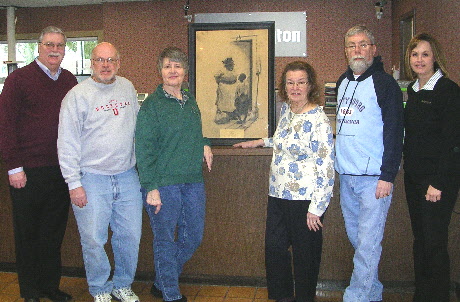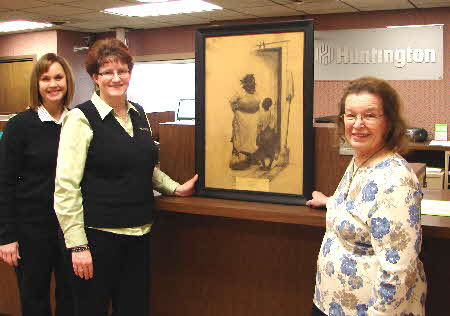|
Huntington Bank donates original Wickey drawing
by Don Allison, Senior Editor of the Bryan Times and SAHC Trustee
Looking for original artwork created by Stryker native Harry Wickey?
For starters, you can visit the New York Metropolitan Museum of Art, the Art Institute of Chicago, the Library of Congress, or the Boston Museum of Fine Arts.
Or if traveling that far isn’t to your liking, you can visit the Stryker Area Heritage Council’s museum.
Wickey’s name may no longer be a household word, even in Stryker, but during his life he was widely known for his etchings, lithography, paintings and sculpture.
Thanks to a donation by Huntington Bank, the Stryker Area Heritage Council has its requisite piece of Wickey artwork, an original charcoal drawing dated 1916.
The drawing depicts an African American woman and boy.
The drawing was presented to the Stryker Area Heritage Council in January. Shown in the photo above (from left to right) are SAHC Trustees Bill Priest, Terry Perkins, Sue Buehrer, Helen Bell, Don Allison and Huntington Bank Stryker Branch Manager Vicki Grimm. In the photo below, Vicki Grimm and Barb Marlin from the Huntington Bank Stryker Branch pose with the drawing and SAHC Trustee Helen Bell
According to Sue Buehrer of the Heritage Council, the drawing was presented by Wickey to Harry Bruns of the former Stryker Exchange Bank. Buehrer said she discovered the drawing years ago in the attic of the former Stryker Farmer’s Exchange Bank, later purchased by the First National Bank of Northwest Ohio. The drawing changed hands with a succession of bank purchases, and ended up in Huntington’s Stryker branch.
Now it will hang in the Stryker Area Heritage Council’s museum in the former Stryker railroad depot. The 1916 drawing is among Wickey’s earlier works.
A quick Internet search will yield images of Wickey’s artwork and notes on his life story.
Wickey spent time in Detroit and Chicago, and eventually moved to New York City. He studied at the Detroit School of Fine Arts and the New York School of Industrial Art, and was both a student and teacher at the Art League of New York.
His first prints were published in 1919. Throughout his career his favorite subjects were rural scenes, based on his experiences in Stryker, as well as images of New York and its inhabitants, and landscapes.
By 1935 the fumes of nitric acid used in his etching plates affected his eyesight, and he eventually turned to lithography and sculpture.
He received a number of awards during his career, including recognition from the Society of American Etchers in 1934, the Guggenheim Fellowship in 1939 and the American Institute of Arts and Letters in 1949. Wickey and his sculptures were featured in the Feb. 23, 1942, edition of Life Magazine.
A detailed account of Wickey’s life is contained in his autobiography “Thus Far,” published in 1941 as part of a series on prominent artists inaugurated by the American Artists Group. In“Thus Far” he wrote at length on his upbringing in Stryker.
“It was on the fourteenth of October, 1892, that the stork came flapping over Stryker, Ohio, with me as a passenger, and I was deposited in a little house in the end of East Lynn Street,” Wickey wrote.
“There was no choice in the matter, but if there had been, I know I would have given his old tail a jerk and said, ‘You may let me off here, please,’ for, as I look back over my childhood and early youth it is with memories that are warm with affection for that environment and all it had to offer.”
He wrote about his early life in Stryker, and of his parents, Victor E. and Alice (Besancon) Wickey.
Harry described his father as a kindly man, but with a severe bearing. “My father was a hard-working man, honest in the extreme, and reserved in temperament, with little to say to us after he had finished his day’s work. He was kindly and thoughtful of our welfare, and we were never wanting in the fundamental physical comforts ...
“He was adamant in his purpose of raising my brother and me in the ways of self reliance, and left no stone unturned to secure that result.
“My mother was of a temperament almost exactly opposite of that of my father,” he wrote, “and I have often thought that the only things my parents had in common were my brother and myself.
“She was vivacious and talkative and, as she loved us more than any other living creatures, was constantly trying to do things to please us. She also desired nothing more than that we should turn out well and be a credit to ourselves and the community and, in her own way, did everything in her power to produce these results.”
Wickey was a frequent visitor to the rural Stryker farms of his grandparents, Mary and Thomas Wickey and Clementine and Charles Besancon, and his exposure to farm life found outlet in his later work.
The Stryker of Wickey’s youth, as he described it, “was a very busy little place ... with two saw-mills, grist-mill, hoop and tile factory, oar finishing works and harness shop, and some two dozen general stores, meat markets and saloons.”
“Stryker was,” he explained, “at that time the trading center where farmers could sell their timber, stock or farm produce, and as the radius from which it drew was fairly large, it got to be a busy little place.”
Wickey left Stryker after his high school graduation, moving to Detroit. With the help of his uncle he landed a job with the Lake Shore railroad as a car checker, and he began his art studies in Detroit.
After the outbreak of World War I, Wickey — like many young men of his day — was drafted into the U.S. Army. He was detailed to the front-line trenches in France, but soon was selected for officers training school.
He returned to Stryker briefly after his army service, then embarked on his career in art that earned him widespread acclaim. Twice married, he apparently left no direct descendants.
Although Wickey died in 1968 at Cornwall Landing, N.Y., his work remains popular with collectors today.
used by permission of the Bryan Times
|



